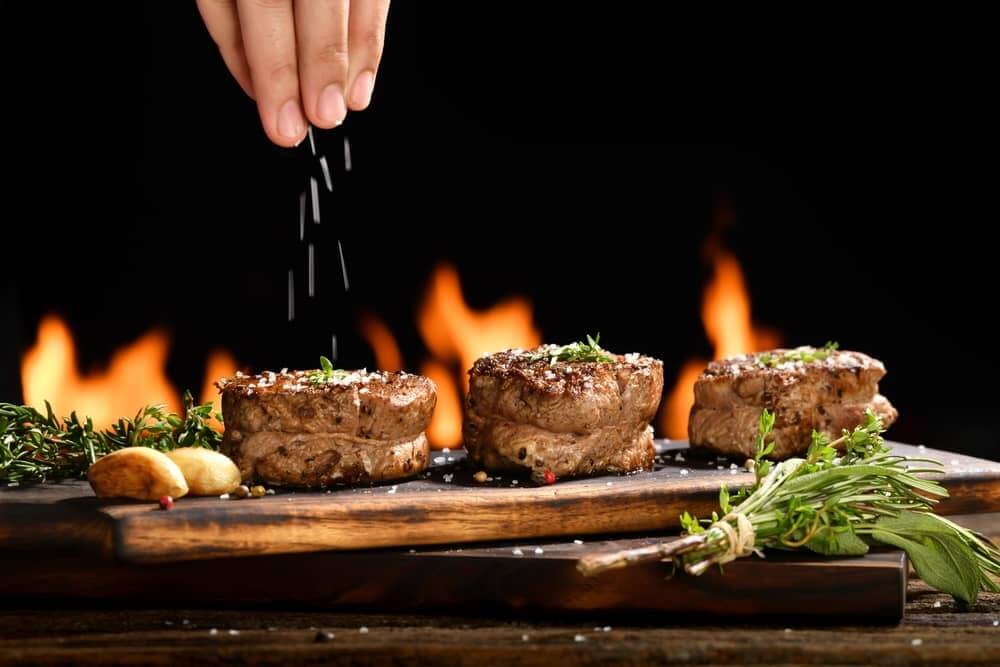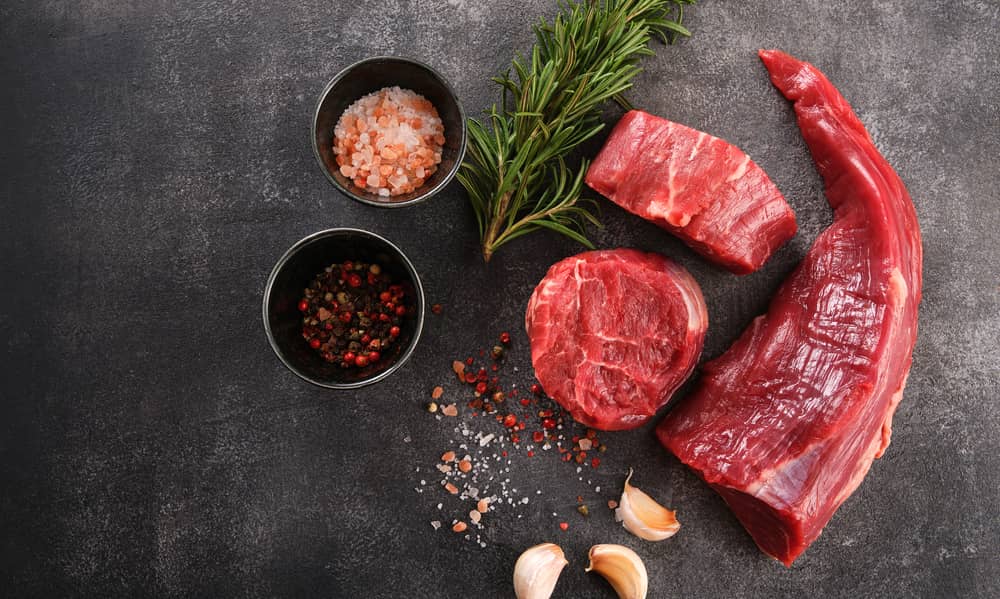
The Filet Mignon is a tender, flavorful cut of beef that remains juicy when cooked correctly. Thanks to subtle but important marbling, fat contributes a rich taste to the meat in addition to giving it a buttery texture. Since some people consider this the very best-tasting cut of beef on a cow, you don’t want to add a lot of powerful seasonings to it. Subtle seasoning is the best approach, especially when baking or grilling. Of course, you may want to mix it up from the usual salt and pepper plan. We’ve got other ideas that will complement the natural flavor of this cut without distracting from it.
Seasoning Filet Mignon
Keep it simple and try one combination at a time. If you’ve never had a Filet Mignon with only salt and pepper, start there. This allows you to appreciate the best of beef before branching out to find new flavor combinations to spice up the routine. Since this is also one of the leaner cuts of steak, it’s easier to incorporate into your regular meal plan. This means you’ll want a few flavor combinations in your repertoire to keep from falling back on the same old seasoning. Rubs are the best choice for Filet Mignon, and most are easily added to olive oil or butter rubbed on the surface of the meat to add a little extra fat for browning and a tasty outer crust from searing.
Recommended Seasonings and Rubs to Use

You can never go wrong by starting out with salt and pepper. In fact, using a generous crust of cracked black pepper over the surface allows you to transform this cut of meat into a Steak au Poivre. For a twist on the usual S&P combination, add some fresh herbs as well for a new take on the same steak. Rosemary is a particularly good choice, but it requires different handling than your usual rubs to perform well with cooking methods like smoking and grilling.
Ingredients
Seasoning with Salt and Pepper
- 1/4 teaspoon of flaky or coarse-ground Kosher salt per steak
- Cracked black pepper to taste
Flavoring with Fresh Herbs
- 2 cloves of minced garlic
- 2 teaspoons of chopped fresh thyme
- 2 teaspoons of chopped fresh marjoram
- ½ teaspoon of chopped fresh sage
- 1 teaspoon cracked black pepper
- 1 teaspoon salt
- ¼ cup of olive oil
This mixture will cover around 16 ounces of Prime Filet Mignon, which can range from 2 to 4 or more steaks depending on size.
Cooking with Rosemary and Pepper
- 1 to 2 sprigs of fresh rosemary per steak
- ½ teaspoon of cracked black pepper per steak
- ¼ teaspoon of salt per steak
Steps
Each method of seasoning these flavorful steaks requires a slightly different approach. You can mix them up and combine them, or you can experiment to find your own ways to season your Filet Mignon for a new culinary experience at home.
Seasoning with Salt and Pepper
Sprinkling these seasonings right on the steak doesn’t always result in even seasoning or good adhesion. When you drop the steak in a pan or flip it on the grill, you’ll find your salt and pepper falling off. Let the Filet Mignon come up to room temperature first. This softens the surface and makes it slightly wetter. If it’s shiny, it’s a little too wet and may dissolve the salt. Pat it dry first with a paper towel, then sprinkle the salt and pepper on one side. Pat the seasoning on or even rub it slightly into the surface for good adhesion. Then flip the steak and repeat. For a dramatic look, you can crack a lot of black pepper into a plate and then roll the tall sides of these steaks in the pepper for a thick coating.
Flavoring with Fresh Herbs
Fresh herbs work best for steaks cooked in the oven or another slow-cooking method. They tend to blacken, burn, or just fall off when used in the pan or grill. Dry herbs can be substituted in the above seasoning recipes, but use only ½ of the listed amount. When flavoring with fresh herbs, cut them all finely and mix well with the black pepper, garlic, and olive oil. Keep the salt separate. Spread this seasoning mixture onto the steaks after they’ve come to room temperature. Sprinkle the salt over the top. There’s no need to rub it in since it will adhere to the oil and herbs. Cook the steak at a low temperature so the herbs and garlic don’t blacken before the meat is done cooking. This kind of herb-crusted seasoning also works better for medium levels of doneness rather than well-done.
Cooking with Rosemary and Pepper
The method of using whole stalks of fresh rosemary, salt, and black pepper works well on the grill and in the smoker, as well as in the oven. It’s a little more work in a pan, but still totally possible. Use whole stalks with healthy stems, trimming them down to two or three-inch sections that fit on the top of the Filet Mignons. Sprinkle on the salt and pepper, patting or rubbing it onto the surface as in the first seasoning method. Then place the sprigs of rosemary on the steaks, keeping them balanced as you move the meat for cooking. When flipping the steaks in the pan, remove the rosemary sprigs with cooking tongs first, then place them back on the other side. Dried rosemary or chopped fresh rosemary can also be added in small amounts to the fresh herb rub method.
Tips and Tricks
Experiment with barbecue rubs and seasonings as well. These products tend to be sweet and salty, which can pair well with the rich flavor of this cut. If you find them too overwhelming, keep it simple with a garlic butter pairing that simply requires some softened butter and minced garlic mixed together and spread on the steak prior to cooking.
Conclusion
You’ve got lots of options for dressing up the Filet Mignon. Of course, you should start out by just trying it with salt and pepper, but there’s nothing wrong with expanding from there. You’ll find new and exciting combinations you can wow guests with at your next dinner party, or just for making your weeknight dinner a little more exciting.

